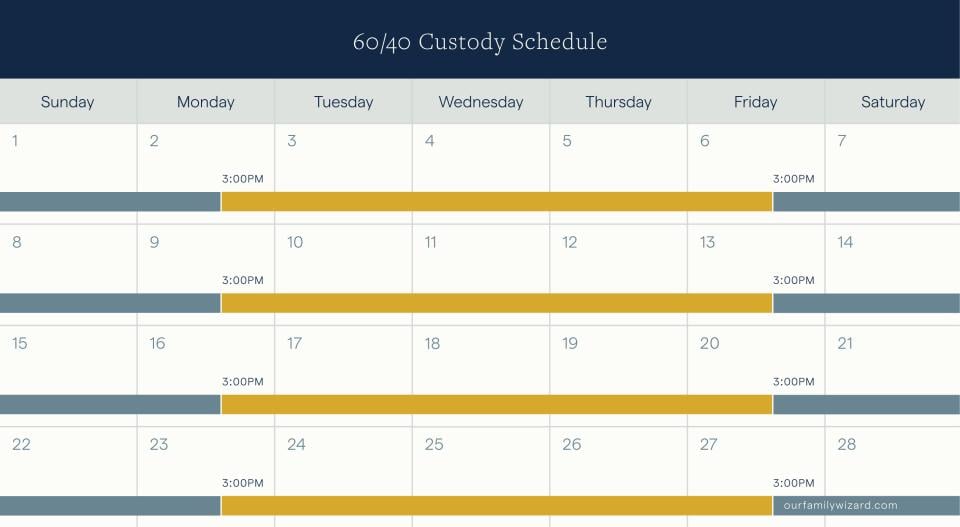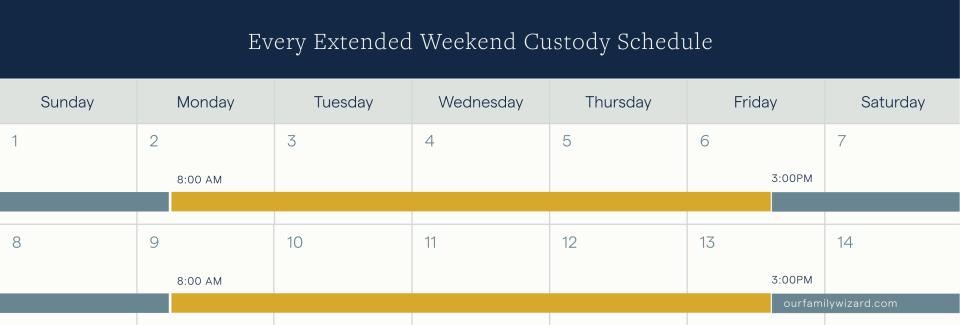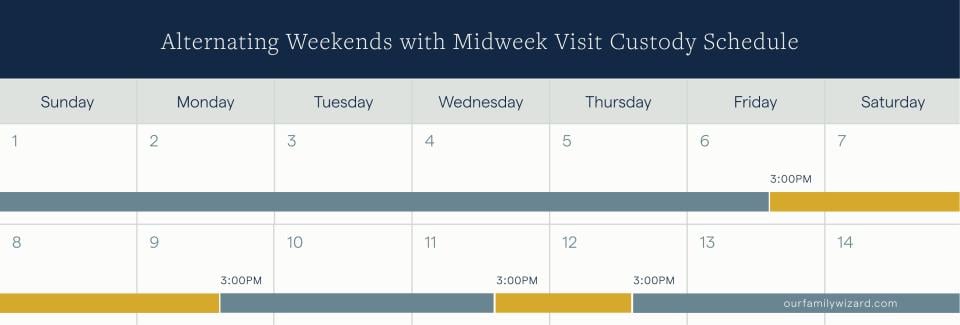60/40 Custody Schedules: Examples and Expert Tips
A popular arrangement among co-parents, 60/40 custody schedules ensure that children spend quality time with both parents. Explore different 60/40 schedules and get expert tips for deciding which 60/40 custody rotation will work best for your family.
Inside this article
What is 60/40 Custody?
60/40 custody describes a rotation where one parent has physical custody 60% of the time, and the other has custody 40% of the time. This schedule usually gives one parent four days per week and three days for the other.
Shared parenting time, also known as shared physical custody, allows parents to play relatively equal roles in raising children, even if the co-parents no longer maintain a relationship or live together. The trend toward shared parenting reflects a growing understanding that children should form and maintain strong relationships with both parents. Moreover, a consistent schedule benefits both parents and children by establishing a routine.
60/40 allows children to spend quality time with both parents and develop meaningful relationships. In most situations, the research suggests that children fare better in shared parenting arrangements than in single-custody arrangements, where one parent spends most of the time with the kids.
 Inna Materese, founder and managing attorney at Materese Family Law, describes the arrangement like this:
Inna Materese, founder and managing attorney at Materese Family Law, describes the arrangement like this:
“A 60/40 schedule is one where each parent enjoys significant physical custody time with the child, but the co-parents don’t have the exact same parenting time. In a true 50/50 schedule, both parents enjoy approximately seven days with the child over a two-week period (seven out of 14 days/nights). A 60/40 schedule is one where one parent has slightly less than exactly equal time with the child over a week or a two-week period.”
With parenting plans, the children’s needs should come first. Also, co-parents can tweak the plans to accommodate their circumstances if they communicate well and agree on any changes.
 On paper, 60/40 schedules give one parent more days of physical custody than the other. In fact, divorce and family law attorney Joseph Cadicina notes that a 60/40 schedule gives “one parent 73 more days per year.”
On paper, 60/40 schedules give one parent more days of physical custody than the other. In fact, divorce and family law attorney Joseph Cadicina notes that a 60/40 schedule gives “one parent 73 more days per year.”
But, in many situations, the children are not with their parents. For example, they may be at school, in an extracurricular activity, or in daycare. In that light, a 60/40 split usually gives co-parents nearly equal opportunity.
Melissa Cohen, a divorce and family law attorney, recommends that “co-parents try not to prioritize achieving a certain percentage of parenting time. Instead, co-parents could consider organizing a schedule based on the child’s best interest.”
 Cohen adds: “As with all shared parenting plans, the co-parents should communicate and cooperate well to make a schedule function well. Also, the parents must reside within a reasonable distance of one another.”
Cohen adds: “As with all shared parenting plans, the co-parents should communicate and cooperate well to make a schedule function well. Also, the parents must reside within a reasonable distance of one another.”
The specifics of 60/40 schedules can differ depending on the children’s needs and ages, plus the parents’ schedules and preferences. You can tailor the schedule to meet your needs and adjust during holidays and special events.
Parenting schedules affect everyone’s lives. Before selecting a plan, explore your options. Consider all relevant factors to ensure your plan meets your family’s needs and preferences.

How Does a 60/40 Custody Schedule Work?
A 60/40 custody schedule means one parent has the child 60% of the time, and the other has the child 40% of the time. The parenting schedule can be arranged in various ways, taking into account the schedules of both co-parents. All practical 60/40 schedules are a variation of the 4-3 plan.
“There are several ways to establish a 60/40 custody schedule,” Matarese notes. “Most often, we use a personalized 4-3 schedule, where one parent has most of the weekdays (the 60%) while the other parent has some weekday responsibility in addition to their custodial weekends (the 40%). Overall, one parent may have 8 out of every 14 overnights while the other has 6 out of every 14.”
60/40 Custody Schedules vs 50/50 Custody Schedules
60/40 and 50/50 schedules are two options that co-parents can use to share custody of children. 50/50 schedules split parenting time evenly, whereas 60/40 schedules give one parent 60% of the time and the other 40% of the time.
Some co-parents place considerable emotional significance to a 50/50 arrangement. Splitting time down the middle can make parents feel like they each have an equal opportunity to raise and bond with their children. However, a 50/50 split won’t work for all parents. Co-parents often need to tweak the 50/50 schedule because their work schedules cannot always accommodate a 50/50 rotation.
60/40 is a near replacement of 50/50, particularly when one parent cannot take the kids during the week and the other co-parent is willing to forgo their weekend with the kids. For example, many co-parents with 9-5 jobs cannot pick up the children from school or handle a mid-week exchange, which most 50/50 schedules (other than an alternating weeks schedule) require. When a co-parent can’t realistically spend meaningful time with their kids during the week, they may opt to have 40% custody over the weekend instead, assuming the other co-parent has a more flexible midweek schedule.
A 60/40 split doesn’t necessarily mean one parent is with a child for longer. In many cases, the children are in school or at another event which could be considered third-party time. Summers and vacations also impact the time each co-parent spends with their children. In general, 60/40 usually gives co-parents the same, or very similar, amount of quality time with their children as 50/50 rotations. Try inserting third-party time into your shared parenting calendar to understand how much time both you and your co-parent will be with the kids.
Simplify your 50/50 custody schedule
Keep your co-parenting organized with OurFamilyWizard.
What Do 60/40 Custody Schedules Look Like?
You can tailor the specifics of your 60/40 plan to your schedule. Some common schedules include variations of the 4-3 schedule. Most co-parents adjust the parenting schedules to maximize each co-parent’s time with children and minimize logistical hassles.
Cadicina, a family and divorce attorney, says co-parents can customize a 60/40 schedule by choosing which days to alternate, then working in reverse to split time 60/40.
"There’s no one-size-fits-all approach to 60/40,” he says. “For example, when both co-parents want to have weekends, they can alternate long weekends, with the kids staying with the 60% co-parent during the week. Then, to maintain the 60/40 split, the 40% co-parent can add in weekday overnights as needed. Parents need to work together and create a custom parenting plan that best suits the needs of their children and their unique family situation."
Examples of 60/40 Custody Schedules
60/40 schedules arrange each week, so one co-parent has physical custody for four days, and the other co-parent has physical custody for three days. The only standard 60/40 schedules are variations of the 4-3 schedule.
The specifics of each family’s 60/40 schedule depend on the child’s needs and the co-parents’ schedule constraints. You can change any parenting arrangement to accommodate for third-party time, holidays, and other special occasions. The co-parents are the fundamental designers of any plan, and so long as both agree, they can change any schedule as they see fit.
Many families begin with a template of a common 60/40 schedule, then make any adjustments they need. Here are examples of schedule variations and their advantages and challenges.
4-3 Custody Schedule
A 4-3 custody rotation is one of the most common and simple ways for co-parents to create a 60/40 parenting plan. One parent has physical custody four days a week, and the other has custody for three days. This schedule minimizes time away and the number of exchanges.A 4-3 schedule can suit a family where one co-parent has limited time to spend with the children during the week. In this case, the co-parent will be with the children for the last three days of the week, Friday-Sunday. However, this means that, depending on the children’s ages, the first co-parent will probably have less free time to spend with the kids during the week; however, they will also have one extra day.
In general, 4-3 can accommodate many situations. However, to make the most of this schedule, co-parents must be able to communicate effectively and maintain a healthy parenting relationship. Also, co-parents in close proximity to each other.
4-3 Parenting Schedule
Every Extended Weekend
The extended weekend schedule is one variation of the 4-3 schedule. The co-parents begin their schedule on Monday morning in the extended weekend schedule. The co-parent with 60% custody time is with the kids from Monday morning through Friday afternoon (four overnight stays). Then, the co-parent with 40% custody is with the kids through the weekend.
Every Extended Weekend Parenting Schedule
The 8-6 Schedule
Some co-parents use the 8-6 schedule, where the parent with 60% custody is with the children for eight days, and the other is with the children the next six days. This means the kids are apart from each parent longer, but it also minimizes the exchanges.
8-6 Parenting Schedule
60/40 Custody with Alternating Weekends (and Midweek Visits)
Sometimes, each co-parent will want to enjoy weekend time with the children. In this case, co-parents can alternate long weekends every other week. The children will stay with the 60% parent during the week. But, to even out the schedule, the parent with 40% custody will get the children for one overnight visit midweek during the week, where they also have weekend custody.
So, in week one, they will have four overnights (one midweek overnight and the three overnights for the long weekend.)
Then, when the 60% co-parent has weekend custody, the 40% co-parent will have the kids for two overnights. So, every two weeks, the 40% co-parent has six overnights out of 14 days (43%), and the 60% co-parent has eight overnights (57%).
As this last schedule shows, you can start by assigning specific days to each co-parent, then work in reverse and add midweek overnights or visits to even out the time.
Alternating Weekends with Midweek Visits Parenting Schedule

Common 60/40 Custody Schedule Errors
Other online resources incorrectly list the 2-2-3 custody schedule as a 60/40 schedule. However, co-parents use 2-2-3 mostly as a 50/50 schedule. In a typical 2-2-3 schedule, the first co-parent spends two days with the children. Then, the children will spend two days with the second co-parent. And then, they return to the first co-parent for three days. In a 50/50 schedule, the co-parents swap days each week.
A 2-2-3 schedule can only create a 60/40 split if the same co-parent is with the kids for the first two sets of two days. In this case, the schedule is identical to the 4-3. However, if the co-parents do not switch days every week, then one co-parent will be with the kids for five days and the other for only two days, which is a 70/30 split.
Custody Considerations for a Summer Co-Parenting Schedule
Many co-parents with school-aged children use a summer co-parenting schedule that differs from the school-year schedule. For example, some co-parents swap their schedule, so the co-parent who had the children during the week now has weekends. If work schedules allow, co-parents can choose a 50/50 split during the summer with a 2-2-3 or 2-2-5-5 rotation.
Top Factors to Consider When Choosing a 60/40 Parenting Schedule
All 60/40 custody schedules provide the children with stability and allow both co-parents to be actively involved in raising the child. To pick a plan, first, consider your child’s age and specific needs. Then, ask whether you can handle the logistical challenges of the schedule.
Materese notes that 60/40 works best for certain types of co-parents and children.
“Children who have significant extracurriculars or childcare needs during the week will benefit from a 60/40 schedule that lets both parents be involved,” she says. “In addition, children who have better learning or homework experiences with one parent versus the other might benefit from a schedule that allows them to spend more time during the week in one home versus the other. Lastly, children with siblings in one home versus another may benefit from slightly more quality in one parent’s household to foster and facilitate sibling relationships.”
Materese also describes the types of co-parents who may enjoy a 60/40 schedule.
“Parents whose work obligations prohibit them from being able to facilitate school or childcare transportation or significant extracurricular activities may benefit from having slightly less physical custody during the week,” she advises. “In addition, parents who want to maximize their quality time via consecutive custodial days might enjoy a 60/40 schedule.”
Here are additional factors to consider when choosing whether 60/40 will work for your family:
- Level of conflict
The 4-3 plan can work well for co-parents in high-conflict relationships that share parenting time for school-aged children. This plan can limit communication between the parents because the parents don’t have to interact to handle exchanges at school.
Materese explains this situation in more detail: “In circumstances where the conflict of the parents may trickle down to the child where frequent exchanges occur, a 60/40 schedule may help alleviate the stress to the family since exchanges can occur at school or daycare. This schedule can limit the frequency of co-parent interactions while giving both parents frequent and consistent quality time with the child.”
However, if both parents want access to weekend time and choose to include midweek visits for the 40% parent, then they will need to communicate and interact regularly. - Work schedules
The 60/40 plan can be a natural fit if co-parents have opposing schedules where one works during the week and the other during the weekend. For example, a teacher might work during the week, but a physical therapist might have to work during the weekend, with some time off midweek. - Ability to be flexible
“Remember, children are going to forget things at the other co-parent’s house or need to grab something from the other house for a sport or school,” says Cohen, a family law attorney. “To accommodate this inevitability, co-parents must embrace building flexibility within their schedule.” - Distance from the home
As with most shared parenting plans, all 60/40 schedules work best when the co-parents live near one another. - Can affect child support
In general, courts use several factors to calculate child support. These factors include each parent's income, the amount of time each parent spends with the child, and the child's needs. When one parent has 60% of the parenting time, they may receive more child support from the other parent than they would if the custody arrangement was split evenly. However, this can vary depending on the specific laws and guidelines in each state and the unique circumstances of each case. Co-parents need to consult with a family law attorney in their area to determine how a 60/40 custody arrangement may impact child support payments.
Suggested 60/40 Parenting Plans by Scenario
The 4-3 schedule remains the go-to 60/40 parenting plan that experts recommend for co-parents with children of all ages. Of course, co-parents can always modify when the schedule starts and add in midweek visits.
Here are tips on which schedules will work best for school-aged children, from preschool to graduating seniors in high school.
For young children (toddlers through age 12): Most parenting experts advise that co-parents consider a 50/50 schedule, like 2-2-3, 2-2-5-5, or 3-4-4-3. These schedules give both parents ample time with growing children who need quality time with each parent to form a healthy, secure attachment. Still, many co-parents cannot handle a 50/50 split because of work or other obligations—if so, a 60/40 split, like the 4-3 plan, will be the next best option.
- For children 12 to 18 years old: The 4-3 plan will work well for children above 12 who have already formed healthy bonds with both co-parents. Teenagers may even prefer the 8-6 schedule, limiting the time they need to switch houses. In this case, parents can ensure both have midweek video or phone calls. If parents can handle a 50/50 split sometimes, they can consider the alternating weeks parenting schedule.
- A note on long-distance co-parenting: A 60/40 plan may not be practical for co-parents who live far apart, as it could lead to excessive travel time for the children, caregivers, and parents, causing additional stress for everyone involved.
60/40 Custody Schedule Templates
Customizing joint custody schedules will help co-parents work together and meet their children’s needs. Use our 60/40 4-3 custody schedule template to visualize which schedule variation will work best for your family.
Why OurFamilyWizard Is the Simplest Way to Track 60/40 Custody Schedules
You can remove the headache of managing a 60/40 custody schedule on a static calendar. OurFamilyWizard gives you access to a color-coded parenting time calendar that lets you easily manage and customize your 60/40 schedule.
Family attorney Inna Materese advises co-parents to use apps to track their shared custody schedules.
“I recommend that co-parents track their schedules on OurFamilyWizard,” she says. “Keeping a family calendar where each parent’s custodial days are clearly marked can ensure that both parents and their children are aware of upcoming exchanges and custodial days. Most importantly, plotting out each parent’s custodial time on a calendar can help ensure predictability and stability for the child at the heart of the custody schedule.”
More than just a calendar, OurFamilyWizard gives you other features to support co-parenting, like messaging, expense and payment tracking, file sharing, and much more.
60/40 Custody Schedule FAQs
Finding answers to common questions will help you navigate the complexities of co-parenting under the 60/40 schedule. For example, learn how 60/40 varies by state and how many overnights a 60/40 schedule typically allows. In addition, get clarity on unusual 60/40 schedules you may find online.
Is 60/40 Custody Considered Joint Custody?
Yes, experts consider 60/40 a form of joint custody, specifically physical custody. Joint physical custody means that both parents share time with the children. In 60/40, both co-parents spend considerable time with the children.
How Many Overnights Are Included 60/40 Custody?
60/40 custody doesn’t include a set standard for the number of overnights. The number of overnights depends on the specific arrangement that co-parents reach. But, in general, 60/40 custody gives one parent four days and four overnights with the children, and the other has three days and three overnights.
For example, in a typical 4-3 schedule, a common 60/40 rotation, the first co-parent be with the kids Monday night, Tuesday night, Wednesday night, and Thursday night (four overnights). Then, the second co-parent picks up the children sometime on Friday. Finally, the children spend Friday night, Saturday night, and Sunday night (three overnights) with the second co-parent.
Again, the number of overnights will ultimately depend on how co-parents decide to design their parenting plan.
How Many Overnights Does 60/40 Custody Provide in a Year?
60/40 custody doesn’t include a set standard for the number of overnights. The number of overnights depends on the specific arrangement that co-parents reach. For example, if one co-parent has four overnights every week, and the other has three, then this amounts to around 208 and 156 overnights.
If you and your co-parent stick to a standard 60/40 schedule, one co-parent will have four overnights per week, and the other will have three. Joseph Cadicina, family and divorce attorney, says, “In a 365-day year, one parent will have 219 overnights, and the other will have 146.”
Does 60/40 Custody Provide Primary Custody?
60/40 can constitute primary custody, but it depends on the laws in your jurisdiction. Check with a local expert to determine whether 60/40 gives primary custody to the parent with 60% of the parenting time in your situation.
What Is an 8/6 Custody Schedule?
You can think of an 8/6 schedule as a doubled-up, two-week version of a 4/3 plan. The co-parent with 60% custody spends eight days with the children, and the other spends six days. Co-parents don’t need to arrange the days in consecutive order.
The 8/6 custody schedule technically allows for a 60/40 split, but because it is a variation of the 4/3, most experts don’t consider it a separate rotation.
What Is a 9/5 Custody Schedule?
In a 9/5 schedule, one co-parent has physical custody for nine days, and the other has physical custody for five days. This schedule sits between a 60/40 and 70/30 split. One co-parent has around 64% of the parenting time, and one co-parent has 34%.
Do 60/40 Custody Parenting Plans Vary by State?
How co-parents manage 60/40 plans can vary by state. Each state has its own guidelines for custody arrangements, and the specific laws and regulations may affect a 60/40 parenting plan. Still, the 4-3 remains the standard 60/40 parenting schedule.
Will a 60/40 Custody Schedule Affect Child Support?
Many states use parenting percentage time to determine child support. However, you should check with experts in your state to determine how your parenting plan will affect child support.
Is There a Custodial Parent in 60/40 Custody?
In a 60/40 custody arrangement, the custodial parent is generally the co-parent with 60% of the parenting time. However, this designation can differ depending on the state or jurisdiction. Seek guidance from local experts to determine whether your plan will have a custodial parent.
Key Takeaways:
- A 60/40 parenting plan allocates 60% of the custody time to one parent and 40% to the other.
- The most common 60/40 parenting plan is the 4-3 schedule. Most other plans are variations of this schedule.
- Co-parents can modify their 60/40 parenting plans to suit their schedules and needs.
- A 60/40 parenting plan requires that co-parents communicate effectively and live near one another.
- A shared calendar and parenting app simplify tracking and managing a 60/40 schedule.











